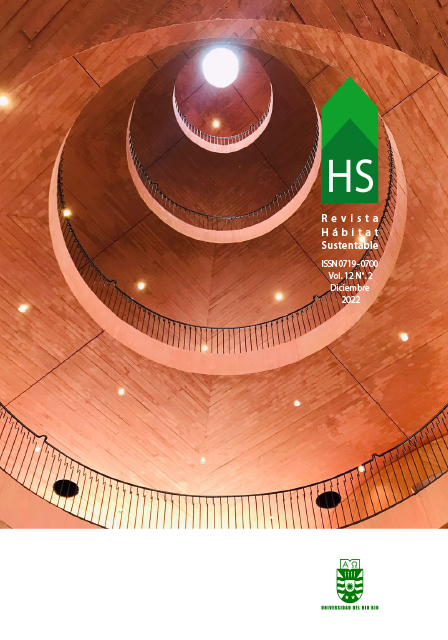The impact of the Covid-19 confinement on the concentration levels of CO2 inside social housing in Chile
DOI:
https://doi.org/10.22320/07190700.2022.12.02.07Keywords:
air pollution, social housing, environmental quality, energy simulationAbstract
More than ever before, the COVID-19 crisis and the need to spend longer periods of time in our places of residence, have highlighted the need to improve indoor air quality (IAQ) and ventilation to reduce the risks of airborne virus transmission. Added to the need to progressively improve the energy performance of our buildings to achieve carbon neutrality is this completely contrary new requirement, which forces reconsidering the ventilation issue, its standards, and technological solutions to improve IAQ and limit the risks of contagion inside our homes, without losing sight of the goals that climate change imposes on us. Chile is seeking strategies to generate sustainable, energy-efficient, and comfortable housing, which must be reconsidered in light of Covid-19. Greater permanence inside the home revealed the precariousness of the lifestyles the most vulnerable families face; sometimes exposing them to environments that are risky for their health. The objective of this research was to estimate the impact of Covid-19 on CO2 indoor air concentrations, as a result of the intensity of use (occupation) of the home, considering envelopes with different levels of airtightness. Using an experimental methodology, based on simulations with the DesignBuilder software, the CO2 concentrations of four types of social housing, located in the commune of Coronel, Biobío, Chile, were quantified. The results showed that confinement increased CO2 levels by 16.4%, while the change from the original condition of the envelope to more airtight levels generated an increase of more than 83% in normal use and 97% for periods of confinement.
Downloads
References
American Society of Heating Refrigerating and Air-Conditioning Engineers [ASHRAE]. (2016). Ventilation and Acceptable Indoor Air Quality in Residential Buildings. ANSI/ASHRAE Standard 62.2-2016., 8400(62.2).
BI, Y., AGANOVIC, A., MATHISEN, H. M. y CAO, G. (2022). Experimental study on the exposure level of surgical staff to SARS-CoV-2 in operating rooms with mixing ventilation under negative pressure. Building and Environment, 217. DOI: https://doi.org/10.1016/j.buildenv.2022.109091
BUSTAMANTE, W., ENCINAS, F., MARTÍNEZ, P., BRAHM, M. e IBACETA, I. (2009). Guía de Diseño para la Eficiencia Energética en la Vivienda Social. Santiago de Chile: Pontificia Universidad Católica de Chile. Recuperado de: http://old.acee.cl/576/articles-61341_doc_pdf.pdf
Citec-UBB – Decon UC (2014). Manual de hermeticidad al aire de edificaciones. Concepción, Chile. Recuperado de: https://citecubb.cl/publicaciones.
Corporación de Desarrollo Tecnológico (2019). Informe Final Uso de la Energía Hogares Chile 2018. Santiago de Chile. Recuperado de: https://www.energia.gob.cl/sites/default/files/documentos/informe_final_caracterizacion_residencial_2018.pdf
CORTÉS, A. y RIDLEY, I. (2013). Efectos de la combustión a leña en la calidad del aire intradomiciliario: La ciudad de Temuco como caso de estudio. Revista INVI, 28(78), 257–271. DOI: https://doi.org/10.4067/s0718-83582013000200008
DAI, H. y ZHAO, B. (2022). Reducing airborne infection risk of COVID-19 by locating air cleaners at proper positions indoor: Analysis with a simple model. Building and Environment, 213. DOI: https://doi.org/10.1016/j.buildenv.2022.108864
Decreto 6 de 2019. Establece Plan de Prevención y de Descontaminación Atmosférica para las comunas de Concepción Metropolitano. 25 de enero de 2018. Recuperado de: https://bcn.cl/2jf1a
Dirección General de Industria - Energía y Minas de la Comunidad de Madrid (2016). Guía de Calidad del Aire Interior. Madrid: Fenercom.
ENCINAS, F., TRUFFELLO, R., URQUIZA, A. y VALDÉS, M. (15 mayo 2020). COVID-19, pobreza energética y contaminación: redefiniendo la vulnerabilidad en el centro-sur de Chile. Ciper. Recuperado de: https://www.ciperchile.cl/2020/05/15/covid-19-pobreza-energetica-y-contaminacion-redefiniendo-la-vulnerabilidad-en-el-centro-sur-de-chile/
GUERRA, J. (18 julio 2020). Realizan diagnóstico que vincula calidad de la vivienda social, pandemia y cuarentenas. Noticias UCN al día – Universidad Católica del Norte. Recuperado de: https://www.noticias.ucn.cl/destacado/realizan-diagnostico-que-vincula-calidad-de-la-vivienda-social-pandemia-y-cuarentenas/
HUNEEUS, N., URQUIZA A., GAYÓ, E., OSSES, M., ARRIAGADA, R., VALDÉS, M., … y CORTÉS, S. (2020). El aire que respiramos: pasado, presente y futuro. Contaminación atmosférica por MP2,5 en el centro y sur de Chile. Recuperado de: https://www.cr2.cl/contaminacion/
LU, Y., NIU, D., ZHANG, S., CHANG, H. y LIN, Z. (2022). Ventilation indices for evaluation of airborne infection risk control performance of air distribution. Building and Environment, 222. DOI: https://doi.org/10.1016/j.buildenv.2022.109440
Ministerio de Desarrollo Social (2019). Informe Desarrollo Social 2019, 14. Recuperado de: https://www.desarrollosocialyfamilia.gob.cl/storage/docs/Informe_de_Desarrollo_Social_2019.pdf
Ministerio de Energía (2020). Estrategia de transición energética de residencial. Vivienda y Densidad, 34. Recuperado de: https://biblioteca.digital.gob.cl/handle/123456789/3774
Ministerio de Fomento (2007). Documento Básico. Septiembre, 2013. Recuperado de: https://www.minrel.gob.cl/minrel_old/site/artic/20080902/asocfile/20080902204316/documento_b__sico_com__n_chile___actualizaci__n_sept_2013_final_con_correcciones_monu.pdf
Red de Pobreza Energética (2019). Pobreza energética. El acceso desigual a energía de calidad como barrera para el desarrollo en Chile. Policy Paper. Santiago: Universidad de Chile.
Downloads
Published
How to Cite
Issue
Section
License
Copyright (c) 2022 Roxana Guíñez-Viveros, Ariel Bobadilla-Moreno, Cristián Alberto Muñoz-Viveros

This work is licensed under a Creative Commons Attribution-ShareAlike 4.0 International License.
The content of articles which are published in each edition of Habitat Sustentable, is the exclusive responsibility of the author(s) and does not necessarily represent the thinking or compromise the opinion of University of the Bio-Bio.
The author(s) conserve their copyright and guarantee to the journal, the right of first publication of their work. This will simultaneously be subject to the Creative Commons Recognition License CC BY-SA, which allows others to share-copy, transform or create new materials from this work for non-commercial purposes, as long as they recognize authorship and the first publication in this journal, and its new creations are under a license with the same terms.











 Scientific Information Program/Concurso Fondos de Publicación de Revistas Científicas 2018/ Proyecto Mejoramiento de Visibilidad de Revistas UBB (Código:FP180007).
Scientific Information Program/Concurso Fondos de Publicación de Revistas Científicas 2018/ Proyecto Mejoramiento de Visibilidad de Revistas UBB (Código:FP180007).





